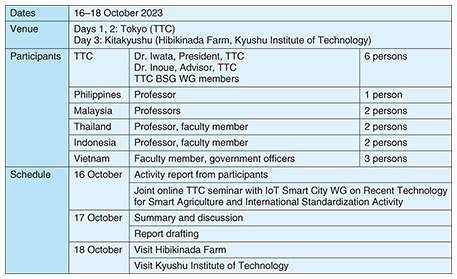 |
|||||||
|
|
|||||||
|
Global Standardization Activities Vol. 22, No. 3, pp. 83–86, Mar. 2024. https://doi.org/10.53829/ntr202403gls Activity Report of TTC Bridging the Standardization Gap Working GroupAbstractThe Bridging the Standardization Gap (BSG) Working Group of the Telecommunication Technology Committee (TTC) held a meeting in October 2023 in Tokyo and Kitakyushu, Japan. The meeting was attended by university professors and government officers from the Asia-Pacific region who work in the fields of information and communication technology (ICT) deployment and promotion of standardization. The topics of the meeting were introduction to the use of ICT in Japan (in fields such as agriculture, aquaculture, education, environment, medical care and disaster response), and discussion between the participants. Keywords: TTC, BSG, ICT 1. What is BSG?The Bridging the Standardization Gap (BSG) activity in general aims to support developing countries and rural areas in using information and communication technology (ICT), deploying standardized technologies, and promoting standardization. BSG is essential to maximize the benefit of global standardization and improve people’s lives. BSG is also one of the five strategic objectives of International Telecommunication Union (ITU)’s standardization sector (ITU-T) [1]. Global standards show their full potential when deployed worldwide because global standards aim to connect the world with the same interfaces, give everyone the same benefit with the same look-and-feel, and reduce cost by the economy of scale. At first glance, BSG seems like a support activity only beneficial to developing countries and rural areas, but it is also beneficial to developed countries because of cost reduction, market expansion, and improvement in convenience, as described above. 2. BSG activities in TTCThe Telecommunication Technology Committee (TTC), the Japanese standards developing organization (SDO) for discussing the contributions from Japan to ITU-T, has been active in BSG in the Asia-Pacific region for over 10 years through its BSG Working Group (WG), with “SHARE” (Success & Happiness by Activating Regional Economy) as its slogan. The BSG WG has collaborated with the Asia-Pacific Telecommunity (APT), the ITU correspondent in the Asia-Pacific region, and developed trusting relations with government organizations and SDOs in the region. On the basis of such relations, it has held several workshops and training sessions every year along with the annual SHARE Meetings. Its activities in 2023 are listed in Table 1. NTT considers BSG activity important and has sent members to the BSG WG since its establishment. The author currently acts as the vice chair of the WG. This article reports the 19th SHARE Meeting held on 16–18 October 2023.
3. The 19th SHARE MeetingTable 2 shows the summary of the 19th SHARE Meeting. In the morning of the first day, after the opening ceremony and summarizing report of the previous meeting, the recent activities were reported from the participants. Their recent major activities were shared, and active discussion was held. Figure 1 shows a photo of the first day. The joint online TTC seminar with TTC’s Internet of Things (IoT) Smart City WG on Recent Technology for Smart Agriculture and International Standardization Activity was held in the afternoon. National activities related to smart cities in Japan, and some advanced enterprise activities in agriculture and aquaculture with ICT were reported. Activities of the ITU-T Focus Group on Artificial Intelligence (AI) and IoT for Digital Agriculture (FG-AI4A), which studies application of AI in agriculture, and activities of the ITU-T Study Group 20 (IoT and smart cities and communities (SC&C)), which studies IoT and smart cities, were also reported. The use of ICT in disaster resilience in the ASEAN (Association of Southeast Asian Nations) community was also reported by one of the SHARE members and opinions were exchanged. On the second day, the summary and report of the first day were produced in the morning, and the participants travelled to the next venue for the third day, Kitakyushu, Fukuoka Prefecture, in the afternoon.
The morning of the third day was the site visit to the large-scale high-tech farm, Hibikinada Farm, as a cutting-edge example of agriculture using ICT in Japan. Figure 2 shows a photo of the site visit. The view of 200,000 tomato plants more than twice the human height in 8.5 ha of land was astonishing. Questioning and discussion with the staff were enthusiastic because there were participants such as professors who study the use of ICT in agriculture and aquaculture in the Asia-Pacific region. Details of ICT usage at the farm was presented after the observation. Computerized monitoring, management and control of the temperature, moisture, carbon dioxide, and culture fluid was presented. The discussion was active between the farm and the participants. For example, when the farm presented that they used coco peat as a nutriculture medium, one of the participants contributed information that coco peat is useful because it has no nutrients and low risk of diseases. The topic went beyond cultivation management to social systems to research budgeting, as the participants included university professors and government officers. It was the moment the full significance of the BSG activity was felt where common issues are shared, and solutions are discussed among people from many countries.
In the afternoon, they visited Kyushu Institute of Technology. Topics such as underwater robot control and aquafarming were presented (Fig. 3). Questions from the participants went deep into the research, such as why a camera was used and not sound, which is used in fish sonar.
4. ConclusionsThe 19th SHARE Meeting, an activity by the BSG WG of the TTC, held in October 2023 was reported. University professors and government officers from the Asia-Pacific region who work in the field of ICT utilization participated in the Meeting. Example practices in Japan were introduced and discussions were held to support and promote deployment of ICT in developing countries and rural areas. Although it was not the focus of this Meeting, the BSG WG also holds standardization-skill-training courses (Table 1). The BSG WG will strive to bridge the standardization gap in the Asia-Pacific region by supporting and promoting deployment of ICT and standardization-skill training. References
|
|||||||














